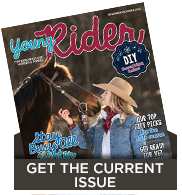
So let’s celebrate colorful coats by exploring some of the fanciest hues in the equine rainbow—buckskin, palomino and pinto.
Buckskin
The first unique horse color is buckskin. If you’ve ever seen the animated movie Spirit: Stallion of the Cimarron or the Netflix original series Spirit Riding Free, then you’re already familiar with the most famous buckskin horses of recent history. Spirit’s color is one of the things that makes him so distinctive and able to stand out from the herd.

Buckskin horses are striking with the combination of a light coat and dark mane, tail, ears and legs. Many buckskins are cream-colored, but some are more golden or tan—it’s the dark points that count. Genetically speaking, a buckskin is a bay horse that has a cream gene, which lightens its base coat to that creamy buckskin shade.
It’s easy to get confused by the terms “dun” and “buckskin,” but duns often have additional dark markings called “primitive” markings. These can include a dorsal stripe along the backbone and stripes above the black points on their legs.
Buckskins can be found in many different breeds, but they can also be registered with the American Buckskin Registry Association, Inc. (ABRA) or the International Buckskin Horse Association (IBHA). Duns and grullas are also included. Grulla (pronounced “grew-yah”) is a mousy grayish-brown shade of dun.
Palomino
Our second unique horse color is palomino. The golden stars of the horse world, palominos always manage to catch your eye with their flashy coats and flaxen manes. It seems as if they were made for the spotlight. After all, palominos have long been a top choice for TV stardom: Trigger was cowboy Roy Rogers’ constant companion, and kids in the 1960s loved to tune in to watch the lovable Mister Ed.

Like buckskin, palomino is not actually a breed but a color, and palomino horses that meet the requirements can be registered with the Palomino Horse Breeders Association (PHBA).
In the olden days, breeders wanted to develop a breed of horse that was always born with a palomino coat, but they discovered that color genes just didn’t work that way. Remember how we said that a buckskin is essentially a bay horse with a cream gene? Well, a palomino is a chestnut horse with a cream gene.
Palomino coats can range in color from light buttery cream to a darker golden yellow. In fact, the PHBA says that “the ideal body coat color is approximately the color of a United States gold coin.” But I think we can all agree that any shade of palomino is a good shade!
Pinto & Paint
Finally, our third unique horse color is pinto and paint. Be careful not to use these words interchangeably—even though pinto and Paint Horse markings look similar, there’s actually a distinction when it comes to bloodlines and registration. The American Paint Horse is a breed of horses known for their striking patterns of white markings that have Quarter Horse breeding, while the word “pinto” can refer to horses of many breeds (including Paints) that display patterns of white markings.

Like palominos and buckskins, pinto horses have their own registry, the Pinto Horse Association of America, Inc. (PtHA).
Pintos and Paints display a variety of beautiful coat patterns, but two of the most well-known are tobiano and overo. A tobiano can usually be identified by minimal white markings on the face, four white legs, and white markings on the body. Overos, on the other hand, often have a lot of white on their faces, sometimes even possessing completely “bald” (white) faces.
The PtHA registers horses and ponies in five different size classifications and six different type classifications, so there’s truly a pinto horse to suit anyone’s fancy!
Learn More About Unique Horse Colors!
Check out the groups that register, show and promote these colorful horses.
- American Paint Horse Association
www.apha.com - American Buckskin Registry Association, Inc.
www.americanbuckskin.com - International Buckskin Horse Association
www.internationalbuckskin.com - Palomino Horse Breeders Association
www.palominohba.com - Pinto Horse Association of America
www.pinto.org
This article originally appeared in the March/April 2019 issue of Young Rider magazine. Click here to subscribe!






One thing to note in the section on Pintos and Paints – there a several breeds which don’t use either of these terms, instead using “Spotted” – among them: Missouri Fox Trotters, Spotted Saddle Horses, and almost all the draft breeds.
Look into the really unique and colorful “PINTALOOSA”. Now those are horses of color! Of course they can’t become a “breed”, but, there is a registry for these unique equines. The Pintaloosa Horse Registry Association. Pintaloosa’s come in all shapes and sizes and of course their most beautiful array of color and patterns! Pintaloosa’s are from the breeding of an Appaloosa and a Paint/Pinto (or visa-versa) and with this there can be an explosion of unique patterns and colors. There is a book that was written in 2008 by Rebecca Rogers called “The Pintaloosa” and contains 100’s of photo’s and descriptions.
No Appaloosas?
You should see dapple grey pinto horses. Those ones are COOL!!!